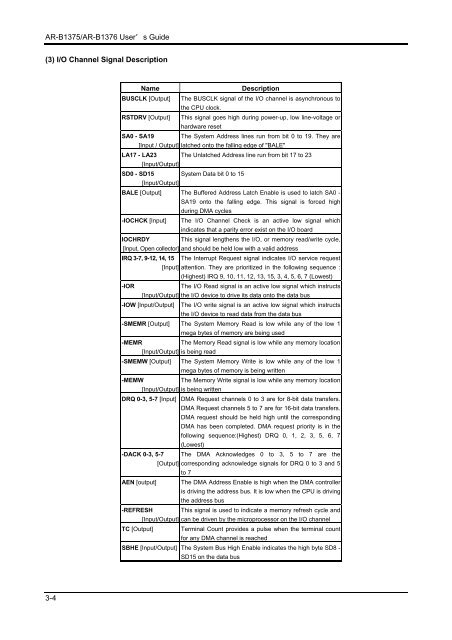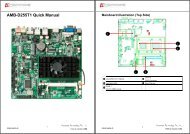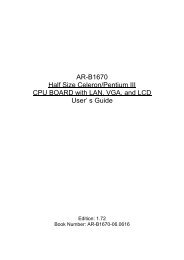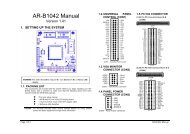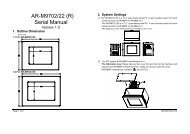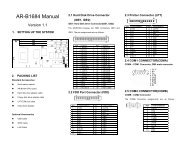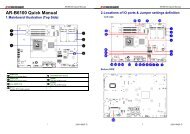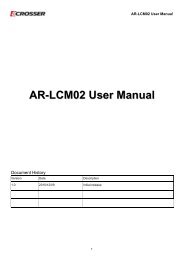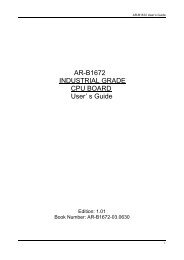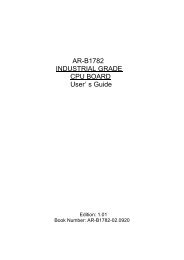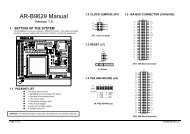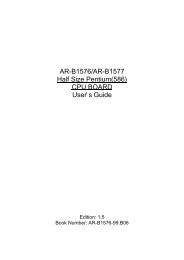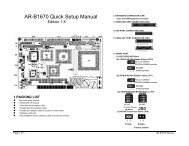Half Size All-In-One 386SX CPU CARD User’ s Guide
AR-B1375/AR-B1376 Half Size All-In-One 386SX CPU ... - Acrosser
AR-B1375/AR-B1376 Half Size All-In-One 386SX CPU ... - Acrosser
- No tags were found...
Create successful ePaper yourself
Turn your PDF publications into a flip-book with our unique Google optimized e-Paper software.
AR-B1375/AR-B1376 Users <strong>Guide</strong><br />
(3) I/O Channel Signal Description<br />
Name<br />
Description<br />
BUSCLK [Output] The BUSCLK signal of the I/O channel is asynchronous to<br />
the <strong>CPU</strong> clock.<br />
RSTDRV [Output] This signal goes high during power-up, low line-voltage or<br />
hardware reset<br />
SA0 - SA19 The System Address lines run from bit 0 to 19. They are<br />
[<strong>In</strong>put / Output] latched onto the falling edge of "BALE"<br />
LA17 - LA23 The Unlatched Address line run from bit 17 to 23<br />
[<strong>In</strong>put/Output]<br />
SD0 - SD15 System Data bit 0 to 15<br />
[<strong>In</strong>put/Output]<br />
BALE [Output] The Buffered Address Latch Enable is used to latch SA0 -<br />
SA19 onto the falling edge. This signal is forced high<br />
during DMA cycles<br />
-IOCHCK [<strong>In</strong>put] The I/O Channel Check is an active low signal which<br />
indicates that a parity error exist on the I/O board<br />
IOCHRDY<br />
This signal lengthens the I/O, or memory read/write cycle,<br />
[<strong>In</strong>put, Open collector] and should be held low with a valid address<br />
IRQ 3-7, 9-12, 14, 15 The <strong>In</strong>terrupt Request signal indicates I/O service request<br />
[<strong>In</strong>put] attention. They are prioritized in the following sequence :<br />
(Highest) IRQ 9, 10, 11, 12, 13, 15, 3, 4, 5, 6, 7 (Lowest)<br />
-IOR<br />
The I/O Read signal is an active low signal which instructs<br />
[<strong>In</strong>put/Output] the I/O device to drive its data onto the data bus<br />
-IOW [<strong>In</strong>put/Output] The I/O write signal is an active low signal which instructs<br />
the I/O device to read data from the data bus<br />
-SMEMR [Output] The System Memory Read is low while any of the low 1<br />
mega bytes of memory are being used<br />
-MEMR<br />
The Memory Read signal is low while any memory location<br />
[<strong>In</strong>put/Output] is being read<br />
-SMEMW [Output] The System Memory Write is low while any of the low 1<br />
mega bytes of memory is being written<br />
-MEMW<br />
The Memory Write signal is low while any memory location<br />
[<strong>In</strong>put/Output] is being written<br />
DRQ 0-3, 5-7 [<strong>In</strong>put] DMA Request channels 0 to 3 are for 8-bit data transfers.<br />
DMA Request channels 5 to 7 are for 16-bit data transfers.<br />
DMA request should be held high until the corresponding<br />
DMA has been completed. DMA request priority is in the<br />
following sequence:(Highest) DRQ 0, 1, 2, 3, 5, 6, 7<br />
(Lowest)<br />
-DACK 0-3, 5-7 The DMA Acknowledges 0 to 3, 5 to 7 are the<br />
[Output] corresponding acknowledge signals for DRQ 0 to 3 and 5<br />
to 7<br />
AEN [output] The DMA Address Enable is high when the DMA controller<br />
is driving the address bus. It is low when the <strong>CPU</strong> is driving<br />
the address bus<br />
-REFRESH This signal is used to indicate a memory refresh cycle and<br />
[<strong>In</strong>put/Output] can be driven by the microprocessor on the I/O channel<br />
TC [Output] Terminal Count provides a pulse when the terminal count<br />
for any DMA channel is reached<br />
SBHE [<strong>In</strong>put/Output] The System Bus High Enable indicates the high byte SD8 -<br />
SD15 on the data bus<br />
3-4


